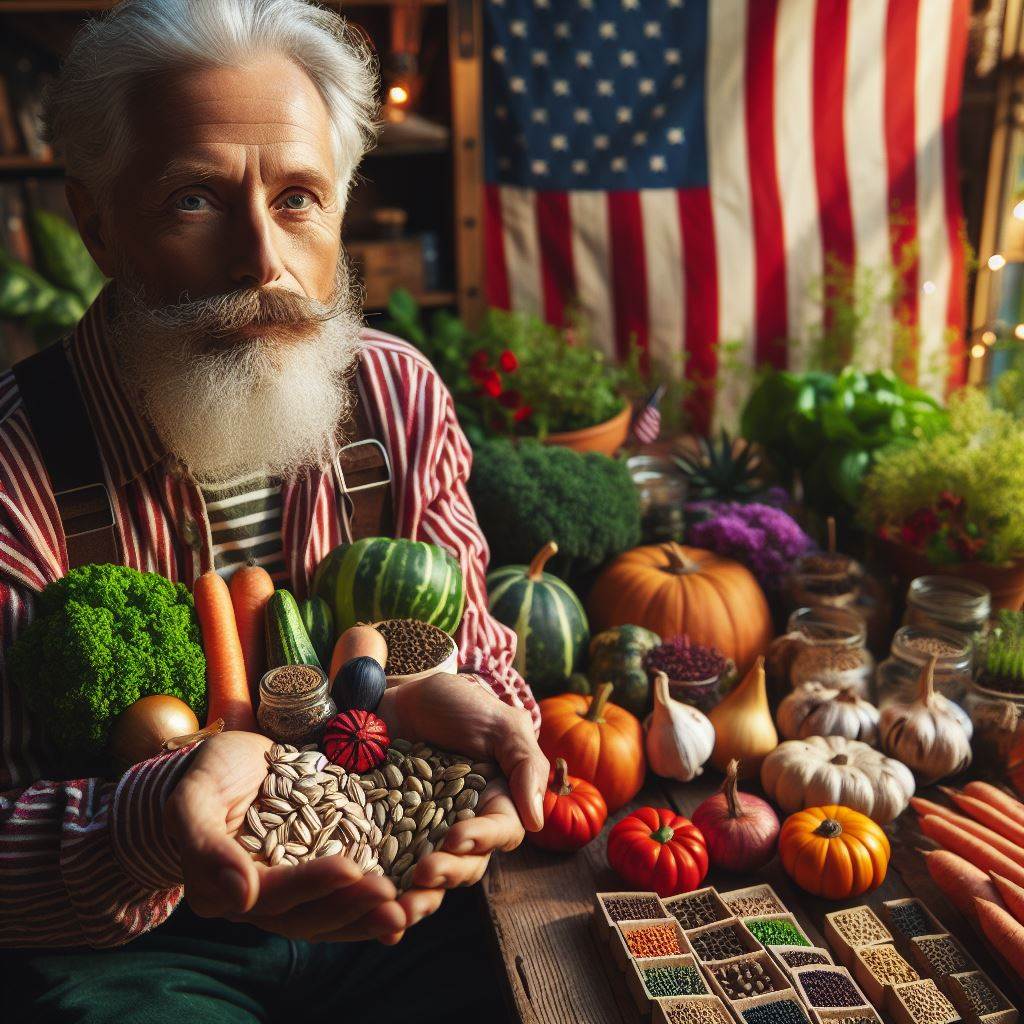Introduction
Preserving plant diversity is crucial for the sustainable future of our planet.
Heirloom seeds play a significant role in this endeavor.
Brief explanation of what heirloom seeds are
Heirloom seeds are open-pollinated plant varieties that have been passed down through generations.
They are genetically stable and true to their original characteristics.
Importance of preserving plant diversity
Preserving plant diversity through heirloom seeds is vital because it safeguards unique traits and flavors.
It allows us to adapt to changing climates, pests, and diseases.
By cultivating heirloom seeds, we maintain a rich genetic bank that can contribute to future crop improvements.
Furthermore, promoting plant diversity protects against the risks of relying on a limited number of uniform crops.
Heirloom seeds have a remarkable flavor and culinary diversity not found in commercially grown produce.
Preserving these seeds ensures food security, taste variety, and cultural heritage.
Preserving plant diversity also promotes ecological balance, as it fosters biodiversity and supports pollinators.
Moreover, heirloom seeds offer greater resilience and adaptability to local conditions than hybrid or genetically modified seeds.
It is our responsibility to preserve and promote the use of heirloom seeds to sustain future generations.
Basically, heirloom seeds are a cornerstone of preserving plant diversity, ensuring food security, and promoting ecological balance.
By using heirloom seeds, we contribute to a sustainable and resilient future for our planet.
Transform Your Agribusiness
Unlock your farm's potential with expert advice tailored to your needs. Get actionable steps that drive real results.
Get StartedHistorical Significance of Heirloom Seeds
The origin of heirloom seeds
Heirloom seeds hold immense historical significance as they are a link to our agricultural past.
These heirloom seeds have been handed down from one generation to another, preserving their unique traits.
The practice of saving and sharing heirloom seeds has led to the preservation of plant diversity.
How heirloom seeds have been passed down through generations
Through the ages, heirloom seeds have been carefully selected by farmers and gardeners for their superior qualities.
Heirloom seeds carry with them the stories of the people who grew and saved them.
These seeds have been passed down from one family member to another, creating a sense of continuity.
They have been treasured by families, who consider the seeds as part of their heritage.
The sharing of heirloom seeds has allowed for the preservation of genetic diversity within plant populations.
These seeds have often been cultivated by indigenous communities, who rely on native crops for sustenance.
Examples of heirloom seed varieties that have historical significance
Many heirloom seed varieties have historical significance, being associated with particular time periods or cultural traditions.
One such example is the Cherokee Purple tomato, a prized heirloom with a rich history.
This tomato variety is believed to have been cultivated by the Cherokee tribe, dating back over 100 years.
The Cherokee people carried the seeds with them on the Trail of Tears, ensuring their survival.
Another example is the Moon and Stars watermelon, which originated in the late 1800s.
This heirloom variety was nearly extinct until it was rediscovered in the 1980s.
The Moon and Stars watermelon is known for its distinctive yellow spots, resembling a night sky.
The Bloody Butcher corn is another heirloom seed variety that holds historical significance.
This red corn dates back to the early 1800s and was an important staple crop for many Native American tribes.
The Bloody Butcher corn was also used in the production of cornmeal and flour.
These examples highlight the diversity and historical value of heirloom seeds.
Importance of preserving plant diversity
Preserving plant diversity through the conservation and planting of heirloom seeds is crucial to our future.
By growing and saving these seeds, we can contribute to the continued existence of unique plant varieties.
The historical significance attached to these seeds serves as a reminder of our connection to the past.
Through heirloom seeds, we honor the knowledge and traditions of those who came before us.
Showcase Your Farming Business
Publish your professional farming services profile on our blog for a one-time fee of $200 and reach a dedicated audience of farmers and agribusiness owners.
Publish Your ProfileIt is our responsibility to ensure that future generations will have access to this rich agricultural heritage.
All in all, the historical significance of heirloom seeds cannot be overstated.
They represent a tangible link to our past, as well as a way to ensure the diversity and resilience of our food system.
Read: Urban Permaculture: Sustainable Tips
Advantages of Heirloom Seeds
Heirloom seeds have gained popularity among gardeners and farmers for several reasons.
In this section, we will explore the advantages of using heirloom seeds over hybrid varieties.
Better taste and flavor compared to hybrid seeds
One of the significant advantages of heirloom seeds is their superior taste and flavor.
Unlike hybrid seeds, which are bred for traits like yield and uniformity, heirloom seeds have been passed down through generations, ensuring their exceptional taste.
Gardeners and farmers who prioritize flavor often prefer heirloom varieties for their unique and delicious qualities.
Ability to adapt to local growing conditions
Another advantage of heirloom seeds is their ability to adapt to local growing conditions.
These seeds have naturally evolved and adapted to specific regions, making them more resilient and better suited for local climates and soils.
By using heirloom seeds, gardeners can enjoy higher success rates and healthier plants that thrive in their specific environment.
Higher nutritional value in some cases
Furthermore, heirloom seeds can have higher nutritional value in some cases.
Industrial agriculture and hybridization often prioritize traits like shelf life and appearance, sacrificing nutritional content.
However, heirloom seeds retain their natural nutritional profiles, providing a healthier choice for consumers who prioritize nutrient-rich food.
More sustainable and environmentally friendly
In addition to taste and nutrition, heirloom seeds are a sustainable and environmentally friendly choice.
Unlike hybrid seeds, which require large-scale inputs like chemical fertilizers and pesticides, heirloom seeds are more self-sufficient and can thrive with minimal external interventions.
This reduces the environmental impact of gardening and farming, making heirloom seeds a more sustainable option for growers who care about the health of the planet.
Moreover, by choosing heirloom seeds, growers play a crucial role in preserving plant diversity.
Many heirloom varieties are at risk of extinction due to the dominance of hybrid seeds and commercial monocultures.
By growing heirloom plants, gardeners and farmers contribute to the conservation of unique and rare plant genetics, ensuring their availability for future generations.
Generally, heirloom seeds offer numerous advantages over hybrid varieties.
From their superior taste and adaptability to local growing conditions, to their higher nutritional value and sustainable nature, choosing heirloom seeds is beneficial for both growers and the environment.
By embracing heirloom seeds, we can preserve plant diversity and enjoy the many unique and exceptional flavors and qualities they offer.
Read: Starting Organic Gardens: A Beginner’s Guide
Threats to Plant Diversity
In today’s modern agricultural practices, there are numerous threats that pose a risk to plant diversity.
These threats include the introduction of hybrid seeds and genetically modified organisms (GMOs), the impact of industrial agriculture, and the loss of traditional farming practices and regional crop varieties.
Hybrid Seeds and Genetically Modified Organisms (GMOs)
- Hybrid seeds are created by cross-breeding different plant varieties to produce offspring with specific desired traits.
- While hybrid seeds may enhance certain characteristics such as yield and disease resistance, they can also lead to a loss of genetic diversity.
- Genetically modified organisms (GMOs) are organisms whose genetic material has been altered using genetic engineering techniques.
- GMOs are typically designed to resist pests, diseases, or herbicides, but their introduction can result in the displacement of native plant species.
- Both hybrid seeds and GMOs can contribute to the homogenization of plant species, reducing overall biodiversity.
The Impact of Industrial Agriculture on Plant Diversity
- Industrial agriculture relies heavily on monocultures, where large areas are dedicated to growing a single crop.
- Monocultures are highly vulnerable to pests, diseases, and climate change, as there is little genetic variation to adapt to changing conditions.
- Furthermore, the use of synthetic pesticides and fertilizers in industrial agriculture can have detrimental effects on soil health and beneficial organisms.
- As a result, plant diversity is significantly reduced, with only a few commercially viable crops dominating the agricultural landscape.
Loss of Traditional Farming Practices and Regional Crop Varieties
- In many regions, traditional farming practices and indigenous crop varieties have been gradually abandoned in favor of modern agricultural techniques.
- Traditional farming methods often involve diverse crop rotations, agroforestry systems, and the use of local seed varieties.
- However, the adoption of industrial agriculture has led to the erosion of traditional knowledge and the loss of local crop varieties.
- This shift towards standardized crops has resulted in the neglect of numerous heirloom plant varieties, leading to a decline in plant diversity.
- Additionally, the globalization of food systems has further contributed to the loss of regional crop varieties and their associated genetic diversity.
In short, there are various threats to plant diversity, including the introduction of hybrid seeds and GMOs, the impact of industrial agriculture, and the loss of traditional farming practices and regional crop varieties.
These factors contribute to the homogenization of plant species, making it crucial to prioritize the conservation and utilization of heirloom seeds to preserve plant diversity.
Read: Urban Farming Essentials for Small Spaces
Importance of Preserving Plant Diversity
In today’s rapidly changing world, the need to preserve plant diversity has never been more crucial.
We are facing unprecedented challenges such as climate change and disease outbreaks, which threaten our food security and the sustainability of agriculture.
Ensuring Food Security in the Face of Climate Change and Disease Outbreaks
- Diverse plant species provide a wide range of genetic resources that enable crops to adapt to changing environmental conditions.
- As climate patterns shift and extreme weather events become more frequent, preserving plant diversity is essential for ensuring a resilient and stable food supply.
- By maintaining a diverse pool of plant genetic resources, scientists and farmers can breed and develop new crop varieties that are more resistant to diseases and pests.
- Heirloom seeds, which are traditional varieties passed down through generations, often possess unique traits that have been naturally selected for their adaptability to local conditions.
- Preserving these heirloom seeds ensures the availability of valuable genetic material for future crop improvement efforts.
Maintaining Genetic Resources for Future Crop Improvement
- Modern intensive agricultural practices have led to the widespread cultivation of a limited number of high-yielding crop varieties, resulting in a loss of genetic diversity.
- Preserving plant diversity is crucial for avoiding genetic erosion and safeguarding the potential for future innovation in agriculture.
- Having a rich gene pool allows scientists to introduce desirable traits into crops, such as drought tolerance, disease resistance, and nutritional enhancements.
- Genetic resources stored in seed banks and botanical gardens serve as a valuable repository for researchers, ensuring their availability for future breeding programs.
- Without the preservation of plant diversity, we risk narrowing our options for developing crops that can withstand emerging challenges and meet the needs of a growing population.
Preserving Cultural and Historical Heritage Associated with Heirloom Seeds
- Heirloom seeds possess cultural and historical significance, representing the agricultural practices and traditions of different communities and regions.
- These seeds have been carefully nurtured and saved by generations, showcasing the rich diversity of plant varieties that were once widely cultivated.
- By preserving heirloom seeds, we maintain a link to our past and honor the efforts of those who came before us in conserving biodiversity.
- Furthermore, heirloom seeds often offer unique flavors, colors, and textures, adding diversity and interest to our diets.
- Embracing heirloom seeds can help preserve cultural heritage, promote local food traditions, and foster a sense of pride and identity within communities.
Essentially, the importance of preserving plant diversity cannot be overstated.
It is not only essential for ensuring food security and adapting to environmental changes but also for maintaining genetic resources and cultural heritage.
Through the conservation of heirloom seeds and the promotion of sustainable farming practices, we can contribute to a more resilient and diverse agricultural future.
Read: Composting 101: Turn Waste into Garden Gold

Steps to Preserve Plant Diversity through Heirloom Seeds
Seed Saving Techniques and Best Practices
- Harvest seeds from heirloom plants at the peak of maturity to ensure genetic viability.
- Avoid cross-pollination by spacing different plant varieties apart or using isolation techniques.
- Properly clean and dry seeds before storing them in airtight containers to maintain quality.
- Label each container with the plant variety, date, and any other relevant information for future reference.
- Regularly check stored seeds for any signs of pests or mold to prevent contamination.
Building Seed Banks and Community Seed Libraries
- Collaborate with local gardeners and organizations to establish a community seed bank.
- Collect and catalog heirloom seeds, ensuring they are properly labeled and organized for easy access.
- Provide resources and education for community members on seed saving and diversity preservation.
- Host seed exchange events or workshops to encourage community involvement and seed sharing.
- Maintain suitable storage conditions to ensure the long-term viability of the preserved seeds.
Supporting Local Farmers and Seed Suppliers who Focus on Heirloom Seeds
- Prioritize purchasing heirloom seeds from local farmers and seed companies that specialize in preserving diversity.
- Engage with local agricultural fairs, farmers’ markets, or community-supported agriculture programs.
- Encourage and support local farmers to grow heirloom varieties, boosting their market demand.
- Advocate for policies that promote the use and protection of heirloom seeds in farming and gardening.
- Spread awareness about the benefits of heirloom seeds and the role they play in preserving plant diversity.
In general, preserving plant diversity through the use of heirloom seeds is a critical endeavor that requires collective effort.
By employing seed saving techniques, establishing seed banks and libraries, and supporting local farmers and seed suppliers, we can safeguard the rich genetic heritage of our crops for future generations.
Challenges and Future Outlook
Availability and accessibility of heirloom seeds
- Heirloom seeds are often difficult to find due to limited commercial availability.
- Many seed companies focus on hybrid and genetically modified varieties, neglecting heirlooms.
- This limited availability poses a challenge for farmers and gardeners interested in preserving plant diversity.
- Seed banks and organizations dedicated to heirloom preservation play a crucial role in maintaining access to these seeds.
- Efforts should be made to increase the production and distribution of heirloom seeds to meet growing demand.
Farmer education and awareness about heirloom seeds
- Many farmers are not aware of the value and importance of heirloom seeds.
- Education programs and workshops can help farmers understand the benefits of using heirloom seeds.
- Training should be provided on seed saving techniques to ensure the longevity of heirloom varieties.
- Collaboration with agricultural institutions and extension services can facilitate knowledge transfer to farmers.
- Increasing awareness among farmers is crucial for the preservation of plant diversity and traditional farming practices.
Potential for increased demand and market growth
- As more people become interested in sustainable agriculture, the demand for heirloom seeds is likely to increase.
- Heirloom seeds offer unique flavors, textures, and colors, appealing to the growing demand for diverse food options.
- Restaurants and specialty markets are recognizing the value of heirloom produce, creating a niche market.
- Supporting small-scale farmers who grow heirloom crops can contribute to the local economy and food security.
- Investing in seed production and marketing infrastructure can facilitate market growth for heirloom seeds.
In a nutshell, the availability and accessibility of heirloom seeds pose challenges to preserving plant diversity. Limited commercial availability requires efforts to increase production and distribution.
Farmer education and awareness are vital, requiring training on seed saving techniques and collaboration with agricultural institutions.
Showcase Your Farming Business
Publish your professional farming services profile on our blog for a one-time fee of $200 and reach a dedicated audience of farmers and agribusiness owners.
Publish Your ProfileHowever, there is potential for increased demand and market growth due to the unique qualities of heirloom seeds.
Supporting small-scale farmers and investing in seed production infrastructure can contribute to the future outlook of heirloom seeds and the preservation of plant diversity.
Conclusion
Heirloom seeds play a crucial role in preserving plant diversity.
These unique and traditional seeds not only offer a wide range of varieties, but they also help maintain genetic diversity in our food system.
Supporting heirloom seed preservation efforts is of utmost importance.
By purchasing heirloom seeds, individuals can contribute to the conservation of rare and endangered plant species.
Furthermore, exploring heirloom seed options for gardening and farming can be an exciting and rewarding experience.
It allows us to connect with our agricultural heritage and embrace the rich flavors and characteristics that heirloom plants offer.
Let us all take a step towards preserving plant diversity by supporting heirloom seeds and advocating for their use in our gardens and farms.
Together, we can protect our food system’s genetic heritage and ensure a sustainable and vibrant future.




